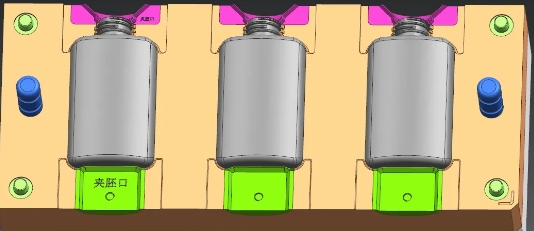What is a blow mold?

Blow molding is a mold used to manufacture blow molded products. Blow molding is a common plastic processing method and is usually used to produce hollow plastic products, such as bottles, containers, barrels, etc.
Blow molds are mainly divided into two types, namely injection blow molds and extrusion blow molds.
Injection Blow Molding Mold: This type of mold is suitable for injection blow molding process. First, the pre-product is injection molded on the injection molding machine, and then the pre-product is put into the blow molding machine. Through heating and blowing, the pre-product is fully expanded in the mold, and finally a molded product is formed. The design of injection blow molding molds needs to consider factors such as the overall shape of the product and wall thickness distribution.
Extrusion Blow Molding Mold: This type of mold is suitable for the extrusion blow molding process. In this process, molten plastic is extruded through an extruder into a tubular blow molded extrudate. This extrudate is then placed into a blow mold, where it is shaped and sized to form a molded product. The design of the extrusion blow mold needs to consider factors such as the shape, size and wall thickness of the extrudate.
Advantages: The cost of blow molding machinery, especially blow molding molds, is low. When molding similar products, the cost of blow molding machinery is about 1/3-1/2 of that of injection machinery, and the production cost of the products is also low. In blow molding, the parison is formed by the machine head under low pressure and blown up under low pressure, mostly 0.2-1.0mpa. Therefore, the residual stress of the product is small and it is resistant to various aspects such as stretching, impact, bending and environment. This strain has higher performance and better usability. In injection molding, the melt must pass through the mold runner and gate at a high pressure of 15-140 MPa, which will lead to uneven stress distribution. The relative molecular mass of blow molding grade plastics, such as PE, is much higher than that of injection grade plastics. The wall thickness of the product is uniform and no post-modification processing is required. The product has no seams and less scrap edges and waste.
Disadvantages: The design requirements of the blow mold should be equipped with an exhaust groove, the bottom should be designed to be concave, and the mold body should be made of corrosion-resistant carbon tool steel and ordinary alloy steel. Tube blank temperature and blow molding temperature. If the temperature is too high, the viscosity of the melt will be low and it will easily deform, causing uneven thickness of the tube blank during transfer. Products with too low temperatures often have more internal stress, and are prone to deformation and stress cracking during use.
The design and manufacturing of blow molds need to take into account factors such as material selection, product shape and size requirements, production efficiency, etc. High-quality blow molds ensure that plastic products are manufactured to specifications. These molds are usually made of metal materials such as steel or aluminum alloy to ensure their wear resistance and durability.
We have professional experience in blow mold manufacturing. If you have any relevant needs, please feel free to contact us at any time.
Connect: +86 15211909120
Email: xia@opro-tech.com